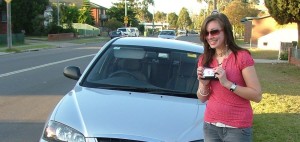GETTING A NSW DRIVING LICENCE
You must be aged 17 years or over to get a NSW driver licence.
If you hold an overseas licence to drive or ride (including a learner licence) and want to get a NSW licence, you must go to a registry or service centre and:
• If your licence is in English, present your overseas licence.
• If your overseas licence is not written in English, provide:
– Your overseas licence and an official translation from the NSW Community
Relations Commission or the Commonwealth Department of Immigration
and Citizenship (DIAC).
– Where extra licence information is required (for example, about the first issue
date or the validity period of the licence or where the type of vehicle authorised
to be driven or ridden is not shown) a letter from a relevant consulate or diplomatic office.
• If you cannot produce your overseas licence, provide:
– A letter from the overseas licence issuing authority confirming your licence
details and status, or,
– A letter from a relevant consulate or diplomatic office, based on information
received from the overseas licence issuing authority, confirming your licence
details and status.
Any letter provided to confirm licence details or status should be in English or
have an official English translation as described above.
Before you first attend the registry or service centre, you may wish to obtain a
letter from the driver licence issuing authority (on its letterhead), or from your
relevant consulate or diplomatic office, confirming your licence details, including
the first issue date.
You must also:
• Prove your NSW address.
• Prove your identity.
• Pass an eyesight test.
• Pass a knowledge test for each class of licence required.
• Pass a driving test for each class of licence required.
• Provide documents proving the first issue date of your licence, if it is not displayed on the licence.
If you fail the driving test, your visiting driver privileges will be withdrawn.
To continue driving in NSW you must then get a learner licence that will allow you to
drive (while supervised by a person who has an Australian full licence) and then go
for another driving test.
RECORDING OVERSEAS LICENCES
Under Australian licensing laws only one licence can be used for driving in
Australia. Before a NSW licence will be issued, you must present your overseas
licence so that the details can be verified and recorded. Your overseas licence will
be returned to you unmarked.
EXEMPTIONS FROM TESTS
You may be exempt from some tests if:
• You have, within the last five years, held an Australian driver licence which can
be verified by the issuing authority, or,
• You hold a current New Zealand driver licence, or,
• You are applying for a Class C (car), or,
• Class R (rider) licence and you hold a current overseas rider licence, or one that
expired within the past five years, from a country recognised as having comparable
licensing standards to Australia.
Note: Roads & Maritime reserves the right to require a driving or riding test. A licence may not be issued unless Roads & Maritime is satisfied that the overseas licence is valid.
WHAT NSW LICENCE YOU ARE ELIGIBLE FOR
The length of time you have held an overseas car or rider licence will determine
the type of licence that you are eligible to hold.
• If you have held your overseas car or rider licence for less than
one year, you will only be eligible for a P1 licence.
• If you have held a car or rider licence for more than one year but less than
three years, you will only be eligible for a P2 licence.
• If you have held a driver or rider licence for more than three years,
you will be eligible for a full licence.
To apply for a class of licence other than one you already hold, you must pass the
appropriate knowledge test and driving test (taken in a vehicle of that class).
TEMPORARY OVERSEAS VISITING DRIVERS
From 18 April 2008, new licensing rules apply to visiting drivers who want to obtain a NSW licence for the first time.
Information for visiting drivers can be found on our website or in the brochure
Guide for international drivers.
DISABLED DRIVERS
When you apply for a licence, you must state whether your disability could affect
your driving. Roads & Maritime will assess your disability as having either a minor
or serious effect on your driving ability. If a disability is considered serious, a
disability driving test has to be taken. Conditions can be placed on your licence, for
example ‘may only drive vehicle with automatic transmission’.
DRIVERS WITH MEDICAL CONDITIONS
You must advise Roads & Maritime if you have a medical condition that could
affect your driving, such as epilepsy.
You are required to give details when you complete an application form, or contact Roads & Maritime should you develop a condition while already holding a licence.
For some medical conditions you will need regular medical examinations to make
sure you are fit to drive. Your doctor should have received a copy of the national
medical guidelines for assessing fitness to drive a motor vehicle. Roads & Maritime
will send a medical report form to be completed by a doctor whenever you are due
for an examination. The completed report must be returned to Roads & Maritime.
Roads & Maritime may suspend or cancel your licence if information is available
that proves you should not be driving. For example, a doctor may report that a
patient does not meet the medical standards and is no longer fit to drive.

